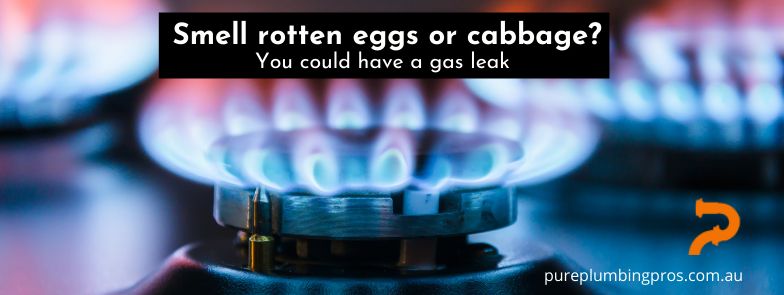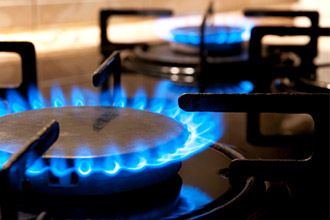What does a gas leak smell like?
Leaking gas smells like rotten eggs or cabbage.
Note: If you smell gas in your home, it needs to be investigated immediately and repaired by a licensed gas fitter.

Natural Gas and LPG
Natural gas and LPG are commonly used in homes and businesses to power gas appliances, stoves, and water heaters.
Both are naturally odourless gases, therefore tert-Butylthiol (t-butyl mercaptan) is added to it so gas leaks can be detected. Mercaptan makes the otherwise odour-free natural gas smell like rotten eggs and cabbage.
It could be due to a gas leak from an appliance. But if you get a faint smell of rotten eggs from the bathroom drains, it could be due to a plumbing issue which is letting the sewage gas to escape through your bathroom drains. Contact your local plumbers to diagnose the issue.
NEED HELP WITH A SUSPECTED GAS LEAK?
Get professional help, book a great Sydney gas fitter here
Our emergency gas plumber is on hand any time of the day and night for all your gas repairs in Sydney - Call 02 9191 7374.
Find out more - Who to contact if you find a gas leak?
How to identify a gas leak?
Quickly identifying a gas leak is essential to keep residents safe and enable repairs to be carried out as soon as possible. Call your local gas fitter if your notice any of the following:
- A hissing sound coming from the gas pipes.
- Dead plants around the gas mains pipes outside your home can be an indicator of gas leaks from the outdoor pipeline.
- Bubbles on standing water outside your home could be due to a leak in the underground gas line. As the gas dissolves in water, it creates bubbles in standing water.
- Dust cloud or unusual air movement near the gas line.
- Flies are sensitive to ethyl mercaptan, so if you see flies buzzing around your gas lines, meter, fittings or appliances, it could be due to a gas leak.

Physical symptoms due to a gas leak
Gas leaks reduce the amount of oxygen in the air and as your body gets less oxygen, you may display symptoms such as:
- Headache
- Nausea
- Breathing difficulty
- Fatigue
- Dizziness
- Irritation in the eyes or throat
If the symptoms get worse when you are home but you feel better if you are outside, there could be a gas leak in your home.
What to do in the event of a gas leak?
Outside your home
If you can smell the gas leak around the meter or near the outdoor gas pipelines, contact your gas provider. You can find the gas provider on your energy bill.
To report a gas leak in Sydney, contact:
- Australian Gas Networks - Gas Leaks and Emergency services on 1800 427 532
- Jemena - Faults and Emergencies 131 909
Inside your home
- Open the windows and doors to allow for ventilation.
- Turn off the gas mains valve.
- Evacuate your home immediately.
- Call a licensed emergency gas fitter who can investigate and fix the leak.
- If you feel unwell, call an ambulance or go to the nearest hospital.
Note: Do not use electrical appliance or your phone inside the home as it can ignite the gas.
Carbon Monoxide
Unlike LPG and natural gas, carbon monoxide doesn’t have a distinct smell making it difficult for humans to detect which it is why it's important to fit carbon monoxide detector in your home. Carbon monoxide is produced when fuel like gas, oil and wood doesn’t burn completely. It can be produced by motor vehicles, space heaters, fireplaces, BBQ, gas and wood stoves.
Check the Flame Colour
- Blue flame - complete combustion
- Red or yellow flame - incomplete combustion
Note: If you see red or yellow flame, it can produce carbon monoxide. It can be dangerous to use the gas appliance, so schedule a gas stove service ASAP.
Signs of Carbon Monoxide leaks
- Check the flame of the gas appliance - if it is yellow-orange, there could be a leak. Contact a licensed gas fitter who can check the appliance.
- Soot stains around the appliance.
- Pilot lights that go off frequently.
Symptoms of carbon monoxide poisoning
Carbon monoxide poisoning can be extremely dangerous. These symptoms can occur when you are home or near the faulty appliance but when you are not at home, you can feel much better. If you have pets, they are also likely to show erratic behaviour.
Watch out for the following symptoms of carbon monoxide poisoning:
- Headaches
- Nausea
- Dizziness
- Vomitting
- Stomach Pain
- Difficulty breathing
- Fatigue
- Unconsiousness
- Asphyxiation
How to prevent gas leaks?
- Keep the gas appliances clean and check for wear and tear regularly.
- Ensure your gas appliances are serviced at least once a year.
- Watch out for any burnt spots or soot stains near your appliances.
- Check the flame colour and if you see a yellow or orange flame, call in a gas plumber for inspection.
